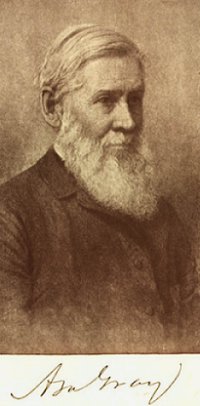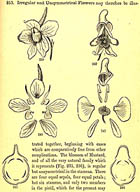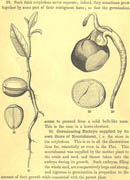Asa Gray
Today, a botanist in a changing world. The University of Houston's College of Engineering presents this series about the machines that make our civilization run, and the people whose ingenuity created them.
What, you might wonder, did nineteenth-century America produce in the way of science? Europe gave us Maxwell, Clausius, Pasteur, Boltzmann, Darwin ... But, in this hemisphere, genius would emerge from far more modest academic infrastructure. Ben Franklin had first set our pattern of scientific independence. In the nineteenth century, people like J. Willard Gibbs carried on in that mold. Our scientists had to be lone pine intellectuals.
 And there was Asa Gray: Gray was born in upstate New York in 1810. He gained a patchy education -- a year here, a lecture there. He became an M.D. at 21, largely through apprenticeship.
And there was Asa Gray: Gray was born in upstate New York in 1810. He gained a patchy education -- a year here, a lecture there. He became an M.D. at 21, largely through apprenticeship.
Gray's real interest was botany. He lasted a year practicing medicine, and then attached himself to a leading American botanist with whom he coauthored a major work: Flora of North America. That led to a faculty post at the new University of Michigan.
Next, Harvard stole him away. There he founded the Boston Botanical Gardens and he shaped the taxonomy of America's vast plant life. While all that made him a very distinguished academic, he did something still more important.
On a visit to England in 1851, he met for lunch with Charles Darwin, and they formed a lasting connection. When Gray returned, he was able to see how our plant life had evolvedunder the disruption of the ice age. A few years later, both Darwin and Wallace proposed that evolution occurred by natural selection. It was Darwin's good luck that his early correspondence with Gray showed that he had been first to articulate the idea.
Then the evolution wars began. Many people tried to radicalize Darwin. Here in America, Gray was pulled two ways: His superstar Harvard Colleague Louis Agassiz said that evolution was nonsense. Agassiz claimed that God not only created the animal species independently, but the Black and White races as well.
The Darwin radicals, on the other hand, tried to say that evolution had removed God from the equation. And we still hear people carrying on the debate in those playground-level terms.
Gray had no use for either extreme. He wrote articles that took on the religious anti-Darwinists as well as the would-be science-based agnostics. Meanwhile, two of Gray's botany texts show his science unfolding: Before Darwin published The Origin of Species, Gray says, "There are [a few plant] species ... in which man has observed the succession for many generations." In other words, he observes evolution even though he doesn't try to explain it.
Thirty years later, he writes: "[different species] represent different adaptation to conditions." And there is Darwin's idea that life adapts to survive. So we watch true science at work. Gray understood that the trick is to present the facts without stirring our convictions in among them. If you and I can only follow suit, then truth will rise like cream without our intervention.
I'm John Lienhard, at the University of Houston, where we're interested in the way inventive minds work.
(Theme music)
J. M. Coulter, Asa Gray, Botanist. Leading American Men of Science,New York: Henry Holt and Company, 1910, pp. 211-231.
A. H. Dupree, Gray, Asa. Dictionary of Scientific Biography. Vol. V (C.C. Gilespie, ed.) (New York: Chas. Scribner's Sons, 1972).
A. Gray, First Lessons in Botany and Vegetable Physiology. (New York: Ivison, Phinney & Company, 1863/1857).
A. Gray, The Elements of Botany: For Beginners and for Schools. (New York: American Book Company, 1901/1887).
Gray's 1857 statement revealing his thinking on evolution and creation is actually hedged thus:
All the descendants from the same stock therefore compose one species. And it was from our observing that the several sorts of plants or animals steadily reproduce themselves, -- or, in other words, keep up a succession of similar individuals, -- that the idea of species originated. So we are led to conclude that the Creator established a definite number of
species at the beginning, which have continued by propagation, each after its kind.There are few species, however, in which man has actually observed the succession for many Generations. ... It could seldom be proved that all the White Pine trees or White Oaks of any forest came from the same stock. But observation having familiarized us with the general fact, that individuals proceeding from the same stock are essentially alike, we infer from their close resemblance that these similar individuals belong to the same species. That is, we infer it when the individuals are as much like each other as are which we know to have sprung from the same stock.
By 1887, the evidence had brought him to interpret difference in terms of adaptive evolution:
The Deviations, as they may be called, form the assumed type or pattern of flower are most various and extensive. The differences between one species and another of the same genus are comparatively insignificant; those between different genera are more striking; those between different families and classes of plants more and more profound. They represent different adaptations to conditions or modes of life, some of which have obvious or probable utilities, although others are beyond particular explanation.
We do not often find scientists riding through paradigm shifts as gracefully as this.
The portrait of Gray, above, is from the Coulter source. Three plant illustrations from Gray (1887) may be seen by clicking on each of the thumbnail images below:



Flower symmetry, fleshy fruit, and an oak acorn